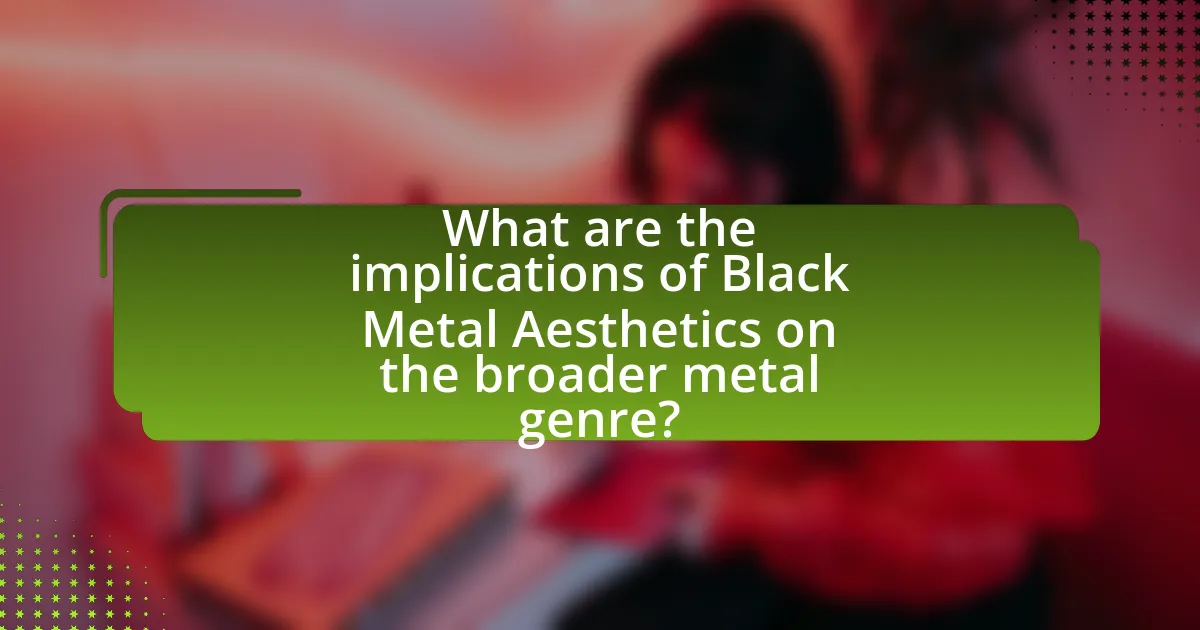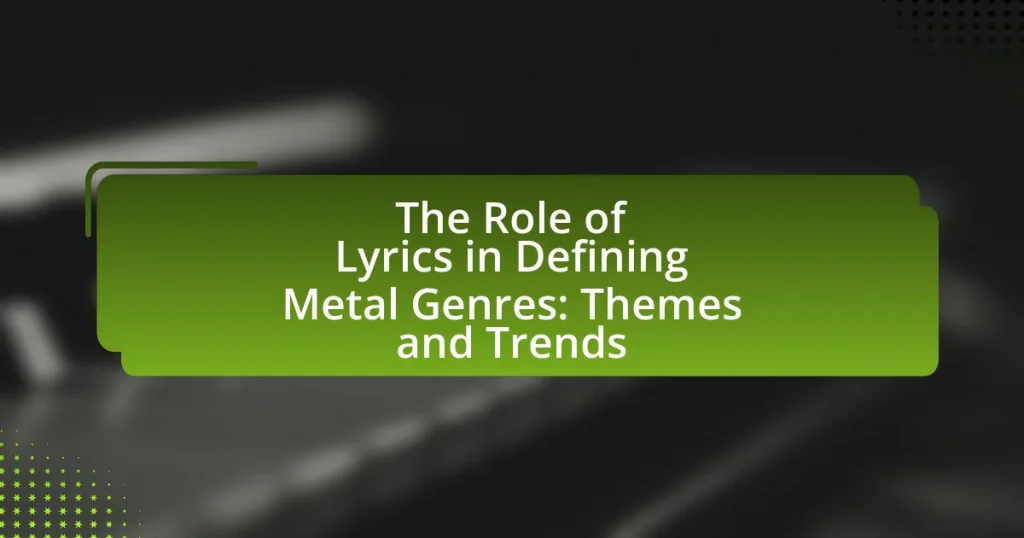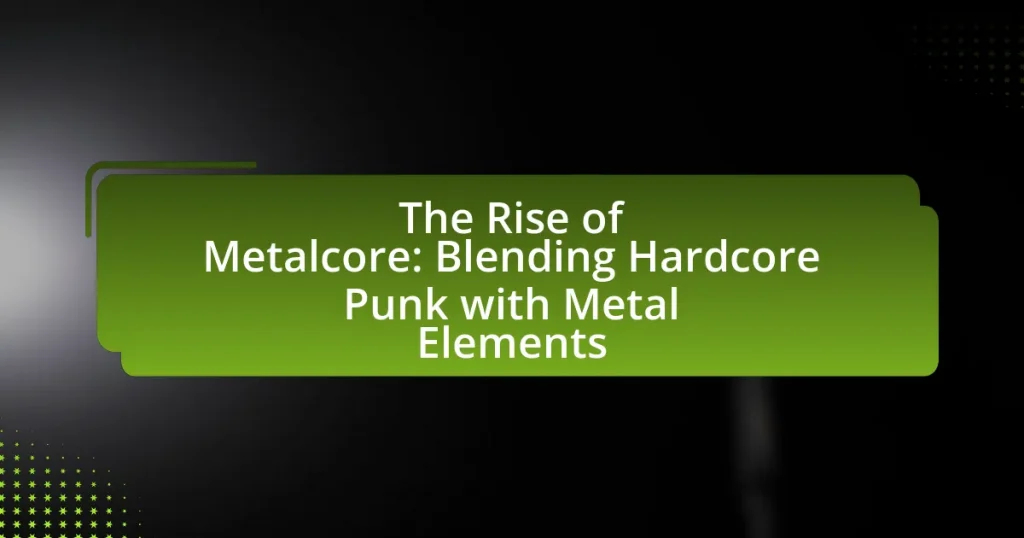Black Metal aesthetics represent a unique visual and thematic style within the metal genre, characterized by dark imagery, anti-religious sentiments, and a focus on nature and mythology. Originating in the early 1980s, these aesthetics have influenced modern metal bands by encouraging theatrical presentations and deeper explorations of dark themes. Key elements include corpse paint, stark visual contrasts, and themes of nihilism and rebellion, which have shaped the identity of contemporary acts like Behemoth and Ghost. The article examines the origins, cultural influences, and the impact of Black Metal aesthetics on modern metal, highlighting how these elements challenge traditional norms and inspire the evolution of sub-genres within the broader metal landscape.

What are Black Metal Aesthetics?
Black metal aesthetics encompass a distinctive visual and thematic style characterized by dark, often nihilistic imagery, and a focus on nature, mythology, and anti-religious sentiments. This aesthetic is manifested through album artwork, stage performances, and band branding, often featuring elements like corpse paint, spikes, and medieval or occult symbols. The genre’s roots in the early 1980s, particularly with bands like Venom and Bathory, established a template that emphasizes a raw, unpolished sound and a rebellious attitude against mainstream culture. The aesthetics have influenced modern metal bands by encouraging a more theatrical presentation and a deeper exploration of dark themes, as seen in the works of contemporary groups like Behemoth and Ghost, who incorporate elaborate visuals and narratives into their music and performances.
How did Black Metal Aesthetics originate?
Black Metal aesthetics originated in the early 1980s as a reaction against the mainstream heavy metal scene, characterized by its dark themes, anti-establishment sentiments, and a focus on the occult and nature. The genre’s visual elements, including corpse paint, dark clothing, and imagery of death and destruction, were popularized by bands such as Venom and Bathory, which laid the groundwork for later acts like Mayhem and Burzum. These bands utilized stark contrasts in their music and visuals to evoke a sense of nihilism and rebellion, establishing a distinct identity that would influence countless modern metal bands.
What cultural and musical influences shaped Black Metal Aesthetics?
Black Metal aesthetics were shaped by a combination of Norse mythology, Scandinavian folklore, and the punk and thrash metal movements. Norse mythology and folklore provided thematic elements such as darkness, nature, and anti-Christian sentiment, which are prevalent in the lyrics and imagery of Black Metal bands. The punk movement contributed a DIY ethic and a raw, aggressive sound, while thrash metal influenced the speed and intensity of the music. These influences are evident in the works of seminal Black Metal bands like Mayhem and Burzum, which incorporated these cultural elements into their music and visual presentation, establishing a distinct aesthetic that has influenced countless modern metal bands.
How do visual elements contribute to Black Metal Aesthetics?
Visual elements significantly contribute to Black Metal aesthetics by creating a distinct and immersive atmosphere that enhances the genre’s themes of darkness, nature, and anti-establishment. The use of stark black and white imagery, often featuring grotesque or surreal visuals, reinforces the music’s emotional intensity and philosophical underpinnings. For instance, album covers frequently depict bleak landscapes, occult symbols, and figures in elaborate costumes, which serve to evoke feelings of dread and mystery. This visual language not only attracts listeners but also establishes a strong identity for the genre, influencing modern metal bands to adopt similar aesthetics in their artwork and performances. The historical context of Black Metal, particularly the Norwegian scene in the early 1990s, showcases how bands like Mayhem and Burzum utilized visual elements to convey their ideologies, further solidifying the connection between imagery and musical expression.
What are the key characteristics of Black Metal Aesthetics?
Black Metal Aesthetics are characterized by a combination of dark themes, raw musicality, and a distinct visual style. The genre often incorporates elements such as anti-religious imagery, nature motifs, and a focus on the occult, which are reflected in album artwork and stage performances. Musically, Black Metal is defined by its fast tempos, shrieking vocals, and atmospheric soundscapes, often utilizing lo-fi production techniques to enhance its rawness. This aesthetic has influenced modern metal bands by encouraging a more theatrical presentation and a deeper exploration of dark themes in their music and imagery.
How does imagery play a role in Black Metal Aesthetics?
Imagery is central to Black Metal aesthetics, serving as a visual representation of the genre’s themes of darkness, nature, and anti-establishment sentiments. This imagery often includes elements such as bleak landscapes, occult symbols, and stark contrasts, which evoke feelings of isolation and nihilism. For instance, album covers and promotional materials frequently feature black and white photography, evoking a raw and unpolished aesthetic that aligns with the music’s aggressive sound. The use of corpse paint by musicians further enhances this imagery, creating a visual identity that is both shocking and memorable, reinforcing the genre’s rebellious ethos. This visual language not only attracts fans but also communicates the underlying philosophies of Black Metal, making imagery a crucial component of its overall aesthetic.
What themes are commonly explored in Black Metal Aesthetics?
Common themes explored in Black Metal aesthetics include nihilism, anti-religion, nature, and the occult. Nihilism often reflects a rejection of traditional values and beliefs, while anti-religion themes frequently critique organized religion, particularly Christianity. Nature is depicted through imagery that emphasizes the beauty and brutality of the natural world, often contrasting human existence with the wilderness. The occult theme delves into mysticism and dark spirituality, drawing on folklore and esoteric traditions. These themes are evident in the lyrical content and visual art associated with the genre, reinforcing its distinct identity within the broader metal scene.

How have Black Metal Aesthetics influenced Modern Metal Bands?
Black Metal aesthetics have significantly influenced modern metal bands by introducing themes of darkness, anti-establishment, and a distinct visual style characterized by corpse paint and elaborate stage setups. This influence is evident in the incorporation of atmospheric elements and lyrical content that explores existentialism, nature, and the occult, which many contemporary bands adopt to create a more immersive experience. For instance, bands like Behemoth and Ghost have integrated these aesthetics into their music and performances, showcasing a blend of theatricality and heavy sound that resonates with the foundational elements of Black Metal. Additionally, the DIY ethic and underground ethos of Black Metal have inspired modern metal acts to prioritize authenticity and artistic expression over commercial success, leading to a resurgence of independent labels and self-produced albums in the genre.
What are the notable changes in Modern Metal Bands due to Black Metal Aesthetics?
Modern metal bands have notably adopted darker themes, atmospheric elements, and a more aggressive sound due to black metal aesthetics. This shift is characterized by the incorporation of high-pitched shrieking vocals, blast beat drumming, and a focus on creating an immersive, often bleak atmosphere in their music. For instance, bands like Behemoth and Ghost have integrated these elements, blending them with their unique styles, which has led to a broader acceptance of diverse influences within the metal genre. Additionally, the visual presentation of modern metal bands has evolved, with many adopting the corpse paint and theatrical stage presence typical of black metal, enhancing the overall aesthetic experience for audiences.
How have lyrical themes evolved in Modern Metal Bands?
Lyrical themes in modern metal bands have evolved to incorporate a broader range of subjects, moving beyond traditional themes of violence and darkness to include personal struggles, social issues, and existential questions. This shift reflects the influence of various subgenres, particularly black metal, which introduced themes of nature, philosophy, and anti-establishment sentiments. For instance, bands like Alcest and Deafheaven blend black metal with shoegaze, exploring themes of nostalgia and emotional depth, while others address contemporary issues such as mental health and identity. This evolution is evident in the lyrics of bands like Spiritbox and Gojira, which tackle personal trauma and environmental concerns, respectively, showcasing a diversification in lyrical content that resonates with a wider audience.
What visual styles have been adopted by Modern Metal Bands?
Modern metal bands have adopted a variety of visual styles, prominently featuring dark, gothic aesthetics, elaborate stage setups, and striking imagery that often includes elements of horror and fantasy. These visual styles are heavily influenced by black metal, which is characterized by its use of corpse paint, dark clothing, and atmospheric backdrops that create a sense of foreboding. Additionally, modern metal bands frequently incorporate multimedia elements such as video projections and intricate lighting designs to enhance their performances, further emphasizing the theatrical aspect of their visual presentation. This evolution in visual style reflects a broader trend within the genre to create an immersive experience for audiences, aligning with the intense and often dark themes present in their music.
Why do Modern Metal Bands incorporate Black Metal Aesthetics?
Modern metal bands incorporate black metal aesthetics to enhance their artistic expression and create a distinct identity. This incorporation often includes elements such as dark themes, atmospheric soundscapes, and visual styles that evoke a sense of mystique and intensity. The influence of black metal can be traced back to its origins in the early 1980s, where bands like Bathory and Mayhem established a raw, aggressive sound and a theatrical presentation that many contemporary metal bands seek to emulate. By adopting these aesthetics, modern metal bands can tap into the emotional depth and cultural significance associated with black metal, allowing them to resonate with a broader audience while also paying homage to the genre’s roots.
What impact does this incorporation have on their identity?
The incorporation of black metal aesthetics significantly impacts the identity of modern metal bands by aligning them with themes of darkness, rebellion, and anti-establishment sentiments. This alignment allows these bands to cultivate a distinct persona that resonates with fans seeking authenticity and depth in their music. For instance, bands like Behemoth and Ghost have adopted visual and thematic elements from black metal, which not only enhances their artistic expression but also solidifies their place within the broader metal community. This incorporation fosters a sense of belonging among fans who identify with the subculture’s values, thus reinforcing the band’s identity as part of a larger movement that challenges societal norms.
How does audience reception change with the use of Black Metal Aesthetics?
Audience reception shifts significantly with the use of Black Metal aesthetics, as these elements evoke strong emotional responses and create a distinct identity for the music. The incorporation of dark imagery, themes of nihilism, and anti-establishment sentiments often attracts listeners who resonate with these concepts, fostering a sense of community among fans. Research indicates that the visual and thematic components of Black Metal, such as corpse paint and bleak landscapes, enhance the immersive experience, leading to deeper engagement and loyalty among the audience. This aesthetic not only differentiates bands within the genre but also influences the perception of authenticity and artistic integrity, which are highly valued by fans.

What are the implications of Black Metal Aesthetics on the broader metal genre?
Black Metal aesthetics significantly influence the broader metal genre by introducing themes of darkness, anti-establishment, and a distinct visual style characterized by corpse paint and atmospheric elements. This aesthetic has led to the emergence of subgenres such as atmospheric black metal and blackened death metal, which incorporate these themes into their music and imagery. For instance, bands like Behemoth and Deafheaven have successfully blended black metal aesthetics with other styles, expanding the genre’s appeal and complexity. Additionally, the DIY ethos prevalent in black metal has inspired many metal musicians to adopt independent production methods, fostering a more diverse and experimental landscape within the metal community.
How do Black Metal Aesthetics challenge traditional metal norms?
Black metal aesthetics challenge traditional metal norms by emphasizing themes of darkness, anti-commercialism, and a raw, unpolished sound. Unlike mainstream metal, which often focuses on technical proficiency and polished production, black metal embraces lo-fi recording techniques and a more aggressive, chaotic musical style. This aesthetic is reinforced by visual elements such as corpse paint, dark imagery, and a focus on nature or mythology, which starkly contrasts with the more glamorous or heroic themes found in traditional metal. The genre’s rejection of commercial success and its embrace of underground culture further differentiate it from mainstream metal, creating a distinct identity that influences modern metal bands seeking authenticity and a deeper connection to their artistic roots.
What are the reactions from the metal community regarding these changes?
The metal community has shown a mix of enthusiasm and skepticism regarding the influence of black metal aesthetics on modern metal bands. Many fans appreciate the incorporation of darker themes and visual elements, viewing them as a revitalization of the genre that adds depth and complexity. For instance, bands like Ghost and Behemoth have garnered significant attention for their theatrical presentations and lyrical content, which resonate with the black metal ethos. However, some traditionalists express concern that these changes dilute the authenticity of metal, arguing that the commercialization of black metal aesthetics risks overshadowing its original underground roots. This divide highlights the ongoing debate within the community about the balance between innovation and tradition in metal music.
How do these aesthetics influence the evolution of sub-genres within metal?
Black metal aesthetics significantly influence the evolution of sub-genres within metal by introducing themes of darkness, nihilism, and anti-establishment sentiments. These elements have led to the emergence of various sub-genres, such as atmospheric black metal, which incorporates ambient soundscapes, and blackened death metal, which blends black metal’s aggression with death metal’s technicality. The visual and lyrical components of black metal, characterized by grim imagery and a focus on nature and mythology, have inspired bands across genres to adopt similar motifs, resulting in a diverse range of styles that reflect these foundational aesthetics. For instance, the incorporation of lo-fi production techniques and theatrical stage presence in bands like Behemoth and Cradle of Filth showcases how black metal aesthetics have permeated and reshaped the broader metal landscape.
What practical tips can Modern Metal Bands use when integrating Black Metal Aesthetics?
Modern metal bands can effectively integrate black metal aesthetics by adopting a raw, atmospheric sound, utilizing dark and cryptic imagery in their artwork, and incorporating themes of nature, mythology, and existentialism in their lyrics. This approach aligns with the foundational elements of black metal, which is characterized by its lo-fi production and haunting melodies. For instance, bands like Deafheaven have successfully blended black metal’s atmospheric qualities with post-metal, demonstrating that modern interpretations can maintain the genre’s essence while appealing to a broader audience. Additionally, using stage presence that includes corpse paint and elaborate costumes can enhance the visual impact, drawing from the theatrical elements that black metal is known for.
How can bands effectively balance their original style with Black Metal influences?
Bands can effectively balance their original style with Black Metal influences by integrating key elements of Black Metal, such as atmospheric instrumentation and thematic darkness, while maintaining their unique sound. This can be achieved through careful arrangement, where bands incorporate Black Metal’s signature tremolo picking and blast beats selectively, ensuring these elements enhance rather than overshadow their original style.
For instance, bands like Opeth have successfully blended progressive rock with Black Metal by using contrasting dynamics and melodic structures, allowing them to retain their identity while exploring darker themes. Additionally, lyrical content can reflect Black Metal’s existential and nihilistic themes without altering the band’s core message, as seen in the works of bands like Enslaved, who fuse Viking themes with Black Metal aesthetics.
By thoughtfully merging these influences, bands can create a cohesive sound that respects both their roots and the Black Metal genre, ultimately appealing to a broader audience while staying true to their artistic vision.
What are common pitfalls to avoid when adopting Black Metal Aesthetics?
Common pitfalls to avoid when adopting Black Metal aesthetics include superficiality, lack of authenticity, and neglecting the cultural context. Superficiality arises when individuals focus solely on visual elements, such as clothing and imagery, without understanding the underlying philosophies and themes of the genre. Lack of authenticity can lead to a disconnection from the music’s roots, as genuine engagement with the genre’s history and values is essential for meaningful expression. Neglecting cultural context may result in appropriation or misrepresentation, as Black Metal is deeply intertwined with specific cultural and historical narratives, particularly in Scandinavia. Understanding these aspects is crucial for a respectful and accurate adoption of Black Metal aesthetics.



